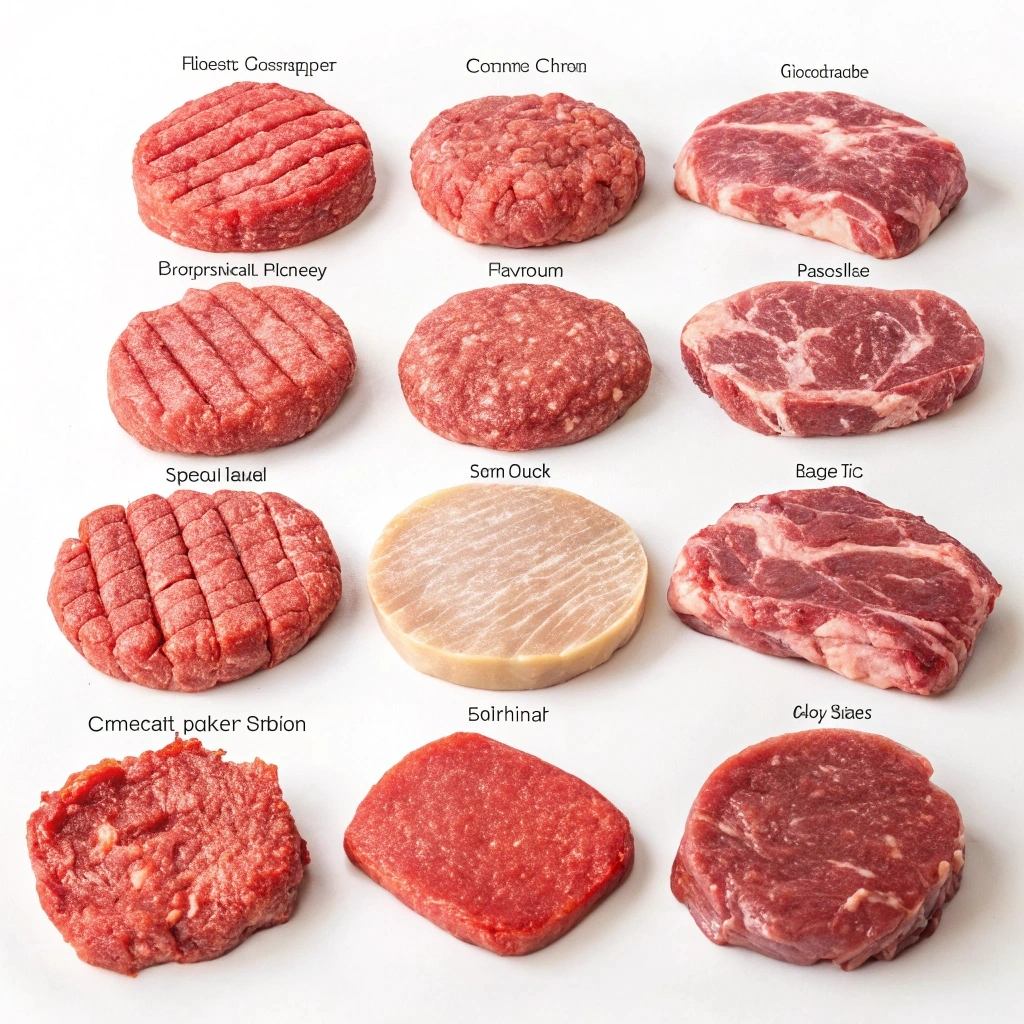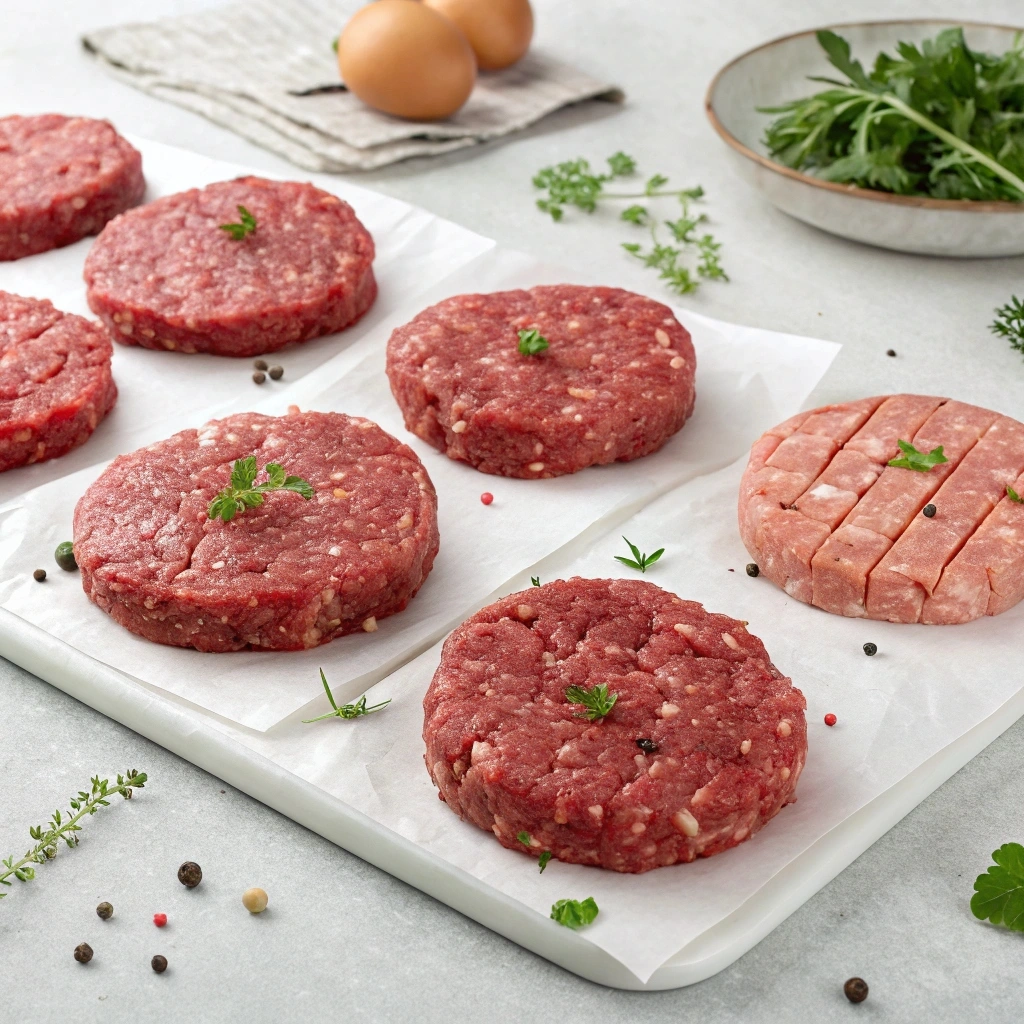Beef Variety for a Hamburger: The Ultimate Cuts You Need
Beef variety for a hamburger is a crucial decision for achieving the perfect juicy and flavorful patty.
Introduction
Beef variety for a hamburger dramatically impacts the final taste, texture, and overall experience. Understanding the different cuts and their characteristics is essential for crafting an incredible burger. The right blend can elevate a simple meal into a culinary masterpiece. Choosing the best beef involves considering fat content, grind, and flavor profile to satisfy your taste buds. It requires knowing the nuances of each cut and how they interact to produce an optimal result. Selecting the right beef variety for a hamburger starts with understanding the options. The exploration of beef choices goes beyond simply selecting what’s available; it’s about understanding how to craft a flavor profile that is uniquely satisfying when considering the beef variety for a hamburger.
Understanding Beef Cuts
The beef variety for a hamburger starts with understanding different cuts. Each cut boasts a unique flavor and fat content. These characteristics significantly influence the final burger. Knowing these differences lets you make informed decisions regarding the beef variety for a hamburger. Understanding the origins and specific attributes of each cut is essential for crafting a truly exceptional burger, when choosing the beef variety for a hamburger.
Chuck
Chuck is a popular beef variety for a hamburger. It comes from the shoulder area. Chuck typically has a fat content of around 15-20%. This fat renders beautifully during cooking. It keeps the burger moist and flavorful. Chuck provides a good balance of meatiness and richness. It’s often considered the gold standard for homemade burgers. The robust flavor and reliable fat content of chuck make it a go-to option for many home cooks and chefs alike when considering the beef variety for a hamburger. Its versatility allows it to stand alone or serve as a foundational element in more complex blends of beef variety for a hamburger.
Brisket
Brisket, from the breast of the cow, is another excellent choice of beef variety for a hamburger. It’s known for its rich, beefy flavor. Brisket contains a good amount of marbling. This breaks down during cooking, adding moisture. Blending brisket with other cuts enhances the overall taste. It provides a robust and satisfying burger, and a great beef variety for a hamburger. The connective tissue within brisket also contributes to a unique texture, adding a pleasant chewiness that complements the tenderness of other cuts for a good beef variety for a hamburger.
Short Rib
Short rib offers a luxurious and flavorful experience as a beef variety for a hamburger. It is one of the fattier cuts. The intense marbling results in an incredibly juicy burger. Short rib’s robust flavor complements other cuts well. Mixing it with leaner beef offers a perfect balance. It adds richness and depth to the overall flavor, making it a great beef variety for a hamburger. Using short rib elevates a burger to a gourmet level, creating a special beef variety for a hamburger. Its decadent qualities transform a simple meal into a truly memorable dining experience, especially when using it as the beef variety for a hamburger.
Sirloin
Sirloin, a leaner cut, offers a different approach as a beef variety for a hamburger. It has a milder flavor compared to fattier cuts. Sirloin benefits from being combined with other cuts with higher fat content. This ensures a balanced and flavorful burger. It can be a good option for those watching their fat intake, when considering beef variety for a hamburger. However, it must be prepared carefully to avoid dryness. While sirloin on its own may not deliver the same punch as fattier cuts, its inclusion in a blend can help to lighten the overall profile and appeal to those seeking a healthier option for their beef variety for a hamburger.
Ground Round
Ground round, another lean option, comes from the rear of the cow. Like sirloin, it requires added fat to prevent a dry burger. Blending ground round with chuck or brisket yields a better result. This adds moisture and flavor. It’s a cost-effective choice, for a beef variety for a hamburger. But, it demands careful consideration of the fat content. Ground round can be a valuable addition to budget-conscious blends when discussing beef variety for a hamburger, but its lean nature necessitates a strategic approach to ensure a palatable final product.
The Importance of Fat Content
Fat content is paramount when selecting the right beef variety for a hamburger. It not only impacts moisture but also carries much of the flavor. Aiming for a fat content between 15-25% generally yields the best results. Too little fat can result in a dry, bland burger. Too much fat can cause the burger to shrink excessively and may lead to a greasy texture, so it’s important to choose the right beef variety for a hamburger. Striking the right balance is crucial for achieving a burger that is both juicy and structurally sound when choosing the beef variety for a hamburger.

Achieving the Ideal Fat Ratio
To achieve the ideal fat ratio, consider blending different cuts when thinking of the ideal beef variety for a hamburger. Combining leaner cuts with fattier ones provides a balanced outcome. For example, mixing ground sirloin with ground chuck or brisket is a common strategy. This allows you to control the final fat content. It ensures a flavorful and moist burger, achieving a perfect beef variety for a hamburger. This technique provides the home cook with a level of customization that can elevate their burger-making to a whole new level when deciding on the best beef variety for a hamburger.
Visual Cues for Fat Content
Visually assessing the beef can provide clues about its fat content. Look for marbling within the meat. Marbling refers to the streaks of fat distributed throughout the muscle. More marbling generally indicates a higher fat content. This will translate into a more flavorful and juicy burger, making the right beef variety for a hamburger. Paying attention to these visual cues can help you make informed decisions at the butcher counter and ensure that you are selecting the best possible beef for your burgers, ensuring the perfect beef variety for a hamburger.
Grind Matters
The grind of the beef impacts the texture of your hamburger. Different grind sizes affect how the meat binds together. It also influences how the burger cooks. Choosing the right grind is an important aspect of achieving the perfect burger when you have the best beef variety for a hamburger. The grind also affects the surface area, which in turn influences browning and overall flavor development in any beef variety for a hamburger.
Coarse Grind
A coarse grind produces a more rustic and textured burger. The larger meat particles create a looser patty. This can result in a juicier burger, but it may also fall apart more easily. Coarse ground beef is ideal for those who enjoy a more substantial bite. It provides a unique texture for a particular beef variety for a hamburger. The looser structure of coarse ground beef allows for more air pockets, which can contribute to a lighter and more tender final product for a specific beef variety for a hamburger.
Medium Grind
A medium grind provides a balance between texture and binding when it comes to your beef variety for a hamburger. It’s a versatile choice that works well with various cuts. Medium ground beef holds its shape better than coarse ground beef. It still offers a pleasant mouthfeel. It is a popular choice for homemade burgers. This grind offers the best of both worlds, combining a satisfying texture with sufficient structural integrity to hold up during cooking and handling for your preferred beef variety for a hamburger.
Fine Grind
A fine grind creates a smoother and more compact patty. This type of grind is often used in fast-food burgers. While it binds well, it can sometimes result in a denser texture. Fine ground beef may not be as juicy as coarser grinds. It’s often used as a less expensive beef variety for a hamburger. While it may not be ideal for those seeking a gourmet experience, fine ground beef can be a convenient option for quick and easy weeknight meals when you want a cheap beef variety for a hamburger.
Top 7 Beef Varieties for an Amazing Hamburger
Choosing the right beef variety for a hamburger is essential. Let’s explore seven incredible options:
80/20 Ground Chuck: This classic choice offers a perfect balance of flavor and fat. It’s readily available and relatively affordable as a beef variety for a hamburger.
Image Placeholder: 80/20 ground chuck in a package. Alt text: 80/20 ground chuck for best hamburger.Brisket Blend: This blend brings a rich, beefy flavor and great moisture. It is perfect for those looking for a step up in taste. Consider it as a premium beef variety for a hamburger.
Image Placeholder: Brisket cut ready to be ground. Alt text: Fresh brisket cut for hamburger meat.Short Rib Blend: It has intense flavor and high fat content. This option is for those who want a luxurious burger experience. Definitely a high end beef variety for a hamburger.
Image Placeholder: Short rib cut for hamburger meat. Alt text: Marbled short rib for hamburger.Chuck and Sirloin Blend: It offers a leaner option without sacrificing flavor. This combination appeals to health-conscious burger lovers, as a beef variety for a hamburger.
Image Placeholder: Mixture of chuck and sirloin. Alt text: Chuck and sirloin mix.The Butcher’s Blend: Many butchers offer their own special blends. It’s worth exploring for unique flavor combinations. Often a great value beef variety for a hamburger.
Image Placeholder: Butcher holding a custom blend of hamburger. Alt text: Butcher’s blend meat variety for a hamburger.Dry-Aged Beef: If you want a bold, intense beefy flavor. Consider dry-aged beef. It is more expensive, but the flavor is unmatched when using it as a beef variety for a hamburger.
Image Placeholder: Dry-aged beef cut. Alt text: Dry-aged beef for hamburger meat.Wagyu Beef: It offers unmatched marbling and tenderness. Wagyu beef is the ultimate indulgence for burger aficionados, and a decadent beef variety for a hamburger.
Image Placeholder: Wagyu beef hamburger. Alt text: Wagyu beef meat variety for a hamburger.
Beyond the Beef: Other Considerations
While the beef is undoubtedly the star of the show, several other factors contribute to the overall burger experience. From bun selection to toppings and condiments, every element plays a role in creating the perfect bite. Think about how to complement your chosen beef variety for a hamburger.
The Perfect Bun
The bun serves as the foundation of the burger. Choosing the right type can significantly enhance the overall experience. Brioche buns offer a rich and buttery flavor, while potato buns provide a soft and slightly sweet taste. Pair your bun choice with the beef variety for a hamburger.
Toppings and Condiments
Toppings and condiments add layers of flavor and texture to the burger. Classic choices include lettuce, tomato, onion, and pickles. However, don’t be afraid to experiment with more adventurous options. Consider how your toppings enhance the beef variety for a hamburger.
Tips for Grinding Your Own Beef
Grinding your own beef offers unparalleled control. It allows you to customize the blend and grind size. This is the best way to achieve your ideal burger. By controlling every aspect of the process, you can ensure that your burgers are perfectly tailored to your preferences regarding beef variety for a hamburger.
Choosing the Right Equipment
Investing in a good quality meat grinder is essential. Stand mixer attachments are available. Dedicated meat grinders offer more power. They will provide better results. Consider the volume of meat you plan to grind regularly when selecting your equipment when thinking about which beef variety for a hamburger to grind.
Preparing the Beef
Before grinding, chill the beef thoroughly. Partially freezing it helps to maintain its shape. It also prevents the fat from smearing. This ensures a cleaner grind. Proper preparation is crucial for achieving a consistent and high-quality grind when focusing on beef variety for a hamburger.
The Grinding Process
Cut the beef into small chunks. Feed it into the grinder. Use a coarse or medium grinding plate. Perform a second grind for a finer texture. This depends on your preference. Experiment with different grinding plates to find the texture that best suits your taste, for your specific beef variety for a hamburger.
Seasoning and Cooking Techniques
The right seasoning enhances the flavor of your beef variety for a hamburger. Proper cooking techniques ensure a juicy and delicious burger. Mastering both of these aspects is essential for creating truly exceptional burgers, regardless of your beef variety for a hamburger.
Simple Seasoning
A simple seasoning of salt and pepper often suffices. This allows the natural flavors of the beef to shine through. Experiment with garlic powder, onion powder, or smoked paprika. These will add depth to your burger. Don’t be afraid to get creative with your seasoning blends, but remember that the goal is to enhance the flavor of the beef, not to mask it, focusing on the beef variety for a hamburger.

The Smash Burger Technique
Smash burgers involve pressing the patty thin on a hot griddle. This creates a crispy crust. It maximizes the Maillard reaction. The Maillard reaction is a chemical reaction between amino acids and reducing sugars that gives browned food its distinctive flavor, enhancing even a simple beef variety for a hamburger.
The Reverse Sear Method
The reverse sear involves cooking the burger at a low temperature. It’s followed by searing it over high heat. This technique ensures even cooking and a flavorful crust. This method allows you to achieve a perfectly cooked burger with a beautiful crust every time, for any beef variety for a hamburger.
Serving Suggestions
Pairing your perfect burger with the right toppings and sides elevates the meal. The right accompaniments can transform a simple burger into a complete and satisfying dining experience, complementing your choice of beef variety for a hamburger.
Classic Toppings
Classic toppings include lettuce, tomato, onion, and pickles. Cheese, bacon, and avocado add richness. Consider the flavor profile of your beef when selecting your toppings to match your beef variety for a hamburger.
Creative Sides
Creative sides include sweet potato fries, onion rings, or a fresh salad. These options offer a variety of flavors and textures that complement the richness of the burger, providing a balanced meal to go with your beef variety for a hamburger.
Conclusion
Selecting the perfect beef variety for a hamburger is an art and a science that requires understanding fat content, grind, and flavor profiles. Experimenting with different cuts, blends, and cooking techniques allows you to discover your ultimate burger. From the classic 80/20 chuck to the decadent Wagyu, there’s a perfect beef variety for a hamburger for every palate. By taking the time to explore the nuances of each option, you can elevate your burger-making skills and create truly unforgettable meals. Happy grilling, with the perfect beef variety for a hamburger!
FAQ
What is the best beef variety for a hamburger?
The best beef variety often involves a blend. A common choice is 80/20 ground chuck. Blending brisket or short rib with chuck enhances the flavor. This will also increase the fat content.
How important is fat content in a hamburger?
Fat content is very important. It contributes to moisture and flavor. Aim for 15-25% fat. This prevents dryness and ensures a juicy burger.
What grind is best for hamburgers?
A medium grind generally provides the best balance. It provides texture. It also ensures that the patty holds its shape.
Is it better to grind your own beef for burgers?
Grinding your own beef offers more control. You can customize the blend and grind size. This results in a burger that perfectly matches your taste.
How do I keep my hamburgers from drying out?
To prevent dry burgers, ensure sufficient fat content. Avoid overcooking. Use a meat thermometer to monitor the internal temperature.
What temperature should hamburgers be cooked to?
Hamburgers should be cooked to an internal temperature of 160°F (71°C). This ensures that they are safe to eat.

